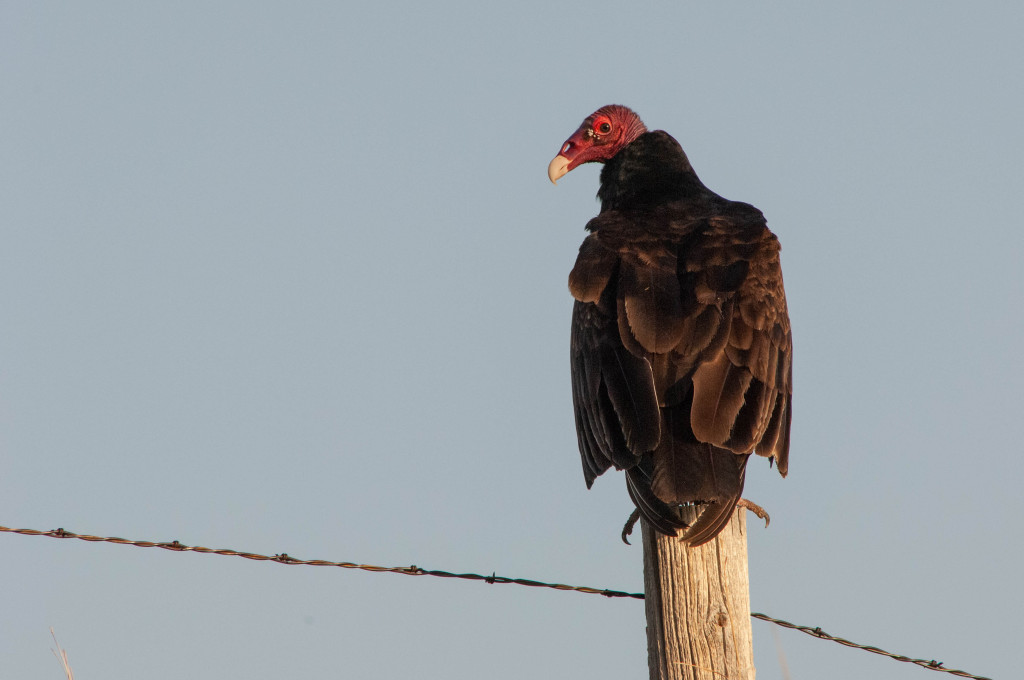
By Monica Macoubrie, Wildlife Education Specialist
If you’ve ever seen large, wobbly-looking black birds flying overhead, congratulations! You were witnessing one of Nebraska’s most efficient cleaning companies at work: Not “buzzard,” not “chicken hawk” — but the turkey vulture.
Identification
When describing the physical appearance of a turkey vulture, you probably wouldn’t call them “beautiful.” These birds are easily recognizable by their large size, black-brown plumage and yellow feet. And you couldn’t forget their naked — some would say creepy-looking — red head. Turkey vultures can be found throughout Nebraska. In fact, springtime is when these migratory birds begin returning to the state from their wintering grounds in Mexico, Central and South America.
Turkey vultures are often mistaken for hawks or other birds of prey while flying, so look for the birds’ distinctive slow, teetering flight style when making an identification. Scientists believe they do this to soar at low altitudes to smell out carrion. These raptors are also known to soar at high altitudes on thermals and form mixed flocks, or kettles. When turkey vultures are on the ground, they move in a hopping motion and are not agile like other members of the vulture family. Identify a turkey vulture in flight by its dihedral “v” shape. In general, the stronger the wind, the more pronounced the “v” shape becomes.
Even though turkey vultures aren’t appreciated as a beautiful animal, they should be valued for the ecosystem services they bring to the table – more on that later.
Super Sense of Smell
It is widely known that turkey vultures eat carrion, or dead animals. Instead of hunting prey with exceedingly sharp talons or fast-as-lightning flight speed, as other raptors do, turkey vultures find their food by their acute sense of smell. Recent studies have found that a turkey vulture’s olfactory bulb – the structure responsible for their sense of smell — is four times larger than that of the black vulture, a close relative, despite having a brain that is a 1/5 smaller. The study also concluded that turkey vultures have more mitral cells than any other species measured; simply put, mitral cells help transmit information about smell to the brain.
To find food, these birds can smell very diluted plumes of volatile gases hundreds of feet above the ground. When they circle their food, they are trying to seek the source of the odor. Contrary to popular belief, turkey vultures can’t predict when an animal is going to die — a myth that has been busted.
Nature’s Cleaning Crew
Without turkey vultures, our landscape would have greater incidences of disease or pestilence, and our roads and highways would certainly be more littered with a larger body count of dead animals. Although humans can’t eat spoiled meat without catching a disease or becoming sick, turkey vultures have impeccable immune systems. These animals can happily feast on carrion without contracting cholera, botulism, anthrax or salmonella. That’s the main reason turkey vultures have “naked” heads, so when they reach into a carcass to eat, they can more easily keep themselves clean.
When feeding, there is a hierarchy as far as who gets to eat first. Most often, there could be several turkey vultures at a single carcass. However, normally one will chase off the others, who will patiently wait their turn.
Adaptations
As if this article hasn’t given you enough reasons to love turkey vultures, let’s dive in deeper to reveal a couple other fascinating adaptations of this raptor. For instance, turkey vultures defecate on their feet during hot weather to cool themselves off. Some scientists believe that since a vulture’s digestive juices kill bacteria, the chemical compounds that make up their waste might even work as an antiseptic. In fact, the turkey vulture’s scientific name, Cathartes aura, literally translates to “cleansing breeze.”
Speaking of waste, let’s discuss vomit. Although few creatures would mess with this large bird that has a 6-foot wingspan and screams death, turkey vultures still need a defense tactic. So, they vomit when they feel threatened, sometimes the projection reaching up to 10 feet. This extremely effective technique serves as a remarkable predator repellent.
Viewing Turkey Vultures
If you’re wanting to see turkey vultures, morning may be one of the best times. Often, you can see these birds standing erect with their wings spread out so the sun can hit them. Presumably, they do this is to warm up, cool off or dry off.
You might also see dozens of these birds performing a “follow flight” display, when one bird leads the others through twisting, turning and flapping sequences that can last as briefly as a minute and up to 3 hours.
Some might see turkey vultures as a nuisance species, but the truth is they clean up our ecosystems and help reduce the risk of harmful bacteria and diseases from spreading. So, next time you see those wobbly birds in the sky, be sure to give them some much-deserved admiration.
